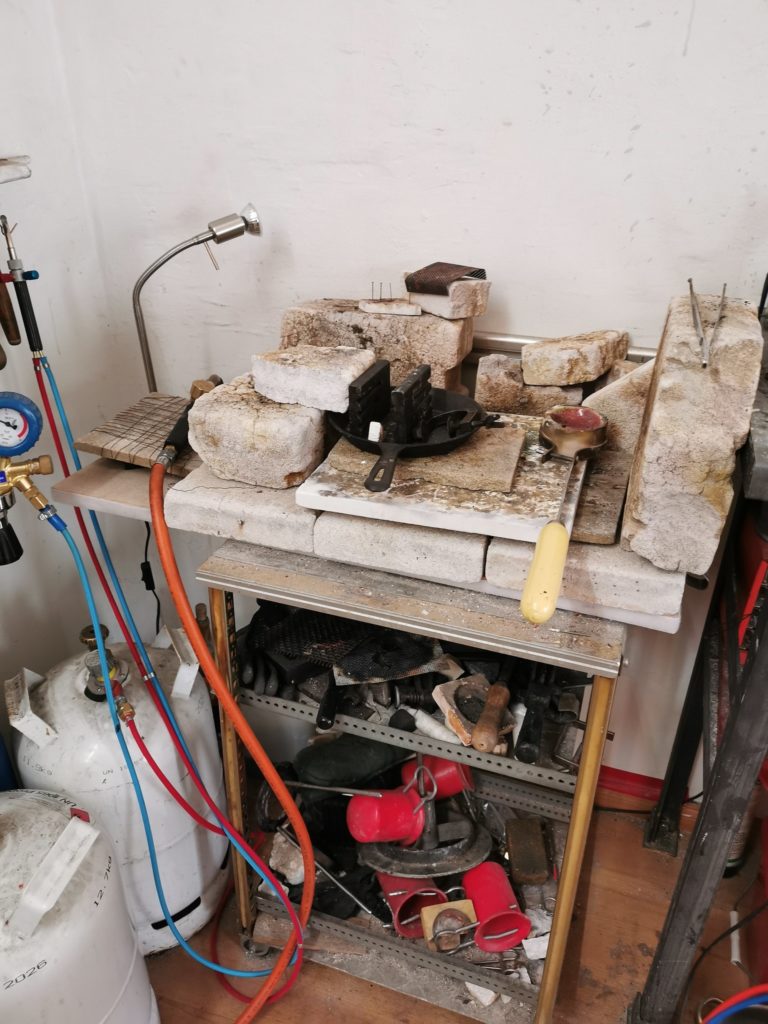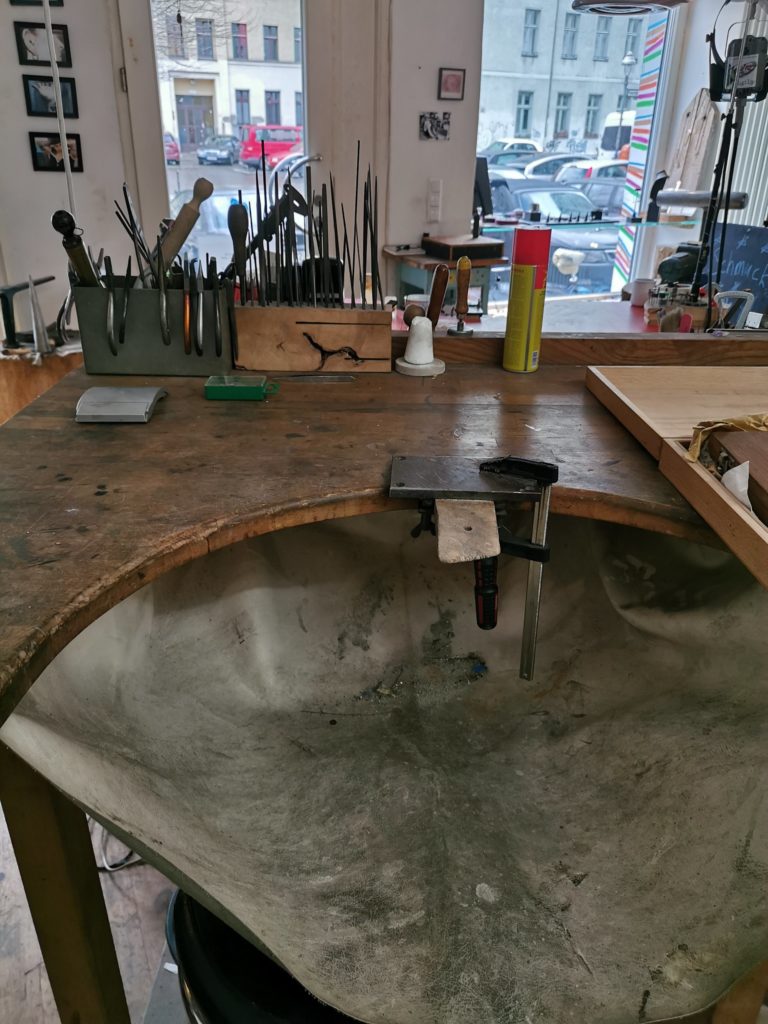with Hannah Perner-Wilson and Irene Posch.
The Open Ends project aims to explore the possible combinations between the craftsmanship of jewellery and the conception of electronic objects.
Le projet Open Ends ambitionne d’explorer les combinatoires possibles entre le savoir-faire artisanal de la bijouterie et la conception d’objets électroniques.
During a first four-day exchange in the Volksluxus workshop (Berlin), we have followed an introduction by Sybille Jagfeld to the techniques of metalworking and more precisely of silversmith. The first days were dedicated to discovering and learning the different tools of the workspace. Manual rolling mills, stretching bench, anvil with martyrdom for stamping, stirring techniques, so many resources to apprehend and integrate into this new process of material processing.
Lors d’un premier temps d’échange, de quatre jours, dans l’atelier Volksluxus (Berlin), nous avons suivi une introduction avec Sybille Jagfeld aux techniques de façonnage du métal et plus précisément de l’argent sterling. Les premiers jours ont été dédiés à la découverte et l’apprentissage des différents outils de l’atelier. Laminoirs manuels, banc à étirer, enclume avec martyre pour emboutir, techniques de brassage, autant de ressources à appréhender et à intégrer dans ce nouveau procédé de mise en oeuvre de la matière.
The process is extremely interesting because even before starting to put in shape the material, it has to be made. To produce sterling silver, copper and silver (925g of silver to 75g of copper) must be melted down and then cast into a bar that can then be formed next.
Le process est extrêmement intéressant car avant même de commencer à façonner la matière, il faut la créer. Pour produire de l’argent sterling, il faut dans un premier temps faire fondre du cuivre et de l’argent (proportion 925g d’argent pour 75g de cuivre) pour ensuite les mouler dans une barre que l’on peut former par la suite.
At each step, the possibilities of integrating electronics are examined, how to make these artifacts sensitive, interactive. Because silver is a very good electrical conductor, the possibilities to re-imagining the shape of an electronic circuit are multiple, like in Peter Vogel‘s productions.
À chaque étape, on jugent les possibilités d’intégration d’électronique, comment rendre ces artefacts sensibles, doués d’interaction. L’argent étant un très bon conducteur électrique, les possibilités pour ré-imaginer formellement un circuit électronique sont multiples, à l’image des productions de Peter Vogel.
After the first few days, the general exploration turned around the notion of communication. Jewels are already an element of communication in a way but could it generate a new paradigm of exchange. A system that could bring a non-verbal or non-written transcription, a simplified, binary language, combining emotions to a singular connection with a close person.
Après les premières journées passées, la réflexion générale s’est portée autour de la notion de communication. Le bijou est déjà un élément de communication en quelque sorte mais pourrait-il générer un nouveau paradigme d’échange. Un système qui pourrait faire appel à une retranscription non verbale ou écrite. Un langage simplifié, binaire, alliant les émotions et une connection singulière avec un proche.
This first phase allowed us to imagine a speculative scenario in which part of the artisanal practice of jewellery evolved to fully integrate electronics, thus creating these communication devices.
Cette première phase nous a permis d’esquisser un scénario spéculatif dans lequel une partie de la pratique artisanale de la bijouterie aurait évolué intégrant pleinement l’électronique créant ainsi ces dispositifs de communication.

Gustave Trouvé, 1865
considérés aujourd’hui comme la première technologie portable
1Bit JEWELRY design/idea

We began to experiment with small modules based on the 1bit textile technique developed by Irene Posch and Ebru Kurbak. This principle consists of creating an electromagnetic field thanks to a coil made of conducting wire through which an electric current flows. This coil is then confronted to a magnet which, depending on the direction of the coil current, will be attracted or repelled. Simple rotation movements are then created, like a pixel with two visual states.
Nous avons commencé à expérimenter des petites modules basés sur la technique du 1bit textile développé par Irene Posch et Ebru Kurbak. Ce principe consiste, à partir d’une bobine faite d’un fil conducteur traversé par un courant électrique, à créer un champ électromagnétique. Celui-ci est ensuite confronté à un aimant qui, selon le sens du courant de la bobine, va être attiré ou repoussé. On crée alors de simples mouvements de rotation, comme un pixel qui aurait deux états visuels.
potentialities
Jewellery knowledge, like all craft practices, cannot be acquired in a few days. The purpose of these four days of learning was mostly to develop a reflection around a speculative craft specifically in the field of jewelry through a scenario and a definition of a potential ecosystem.
Le savoir-faire de bijouterie, comme l’ensemble des pratiques artisanales, ne s’acquièrent pas en quelques jours. L’enjeu de ces quatre jours d’apprentissage fut avant tout de développer une réflexion autour d’un artisanat spéculatif au sens large et plus précisément dans le domaine de la bijouterie grâce à un scénario et une définition d’un écosystème potentiel.

Anthony Dunne and Fiona Raby
Speculative everything : Design, fiction and social dreaming, 2013
The next step would be to propose to jewellery craftsmen to produce these artefacts representative of a plausible evolution of their practice in order to experience this hybrid production.
La prochaine étape suivante serait de proposer à des artisans bijoutiers d’être en situation de produire ces artefacts représentatifs d’une plausible évolution de leur pratique et donc de leur transmettre les éléments afin de faire l’expérience de cette production hybride.














